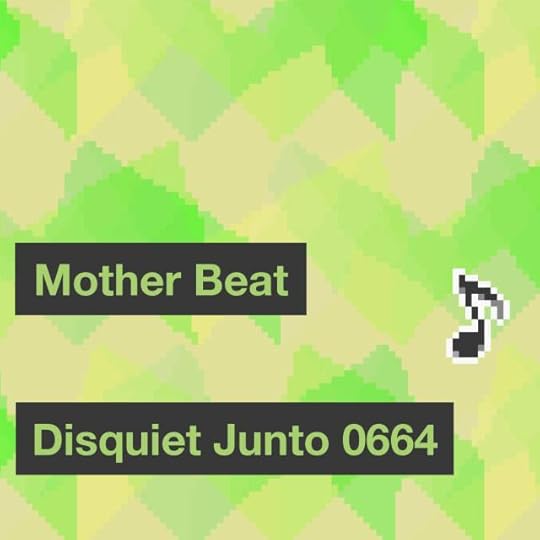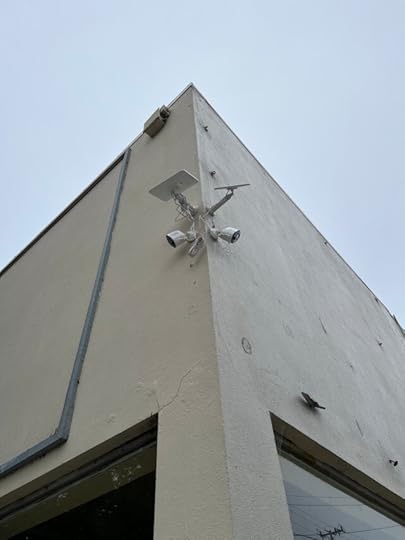Marc Weidenbaum's Blog, page 47
September 21, 2024
Scratch Pad: Fog, Auth, THX
I do this manually at the end of each week: collating most of the recent little comments I’ve made on social media, which I think of as my public scratch pad. I also find knowing I will revisit my posts to be a positive and mellowing influence on my social media activity. I mostly hang out on Mastodon (at post.lurk.org/@disquiet), and I’m also trying out a few others. And I generally take weekends off social media.
▰ The funny thing about the marine layer is how you hear foghorns on sunny days, because the bay is filled with fog while the city skies are clear. Funnier still — odder still — are the days when it’s incredibly foggy out, and yet you hear no foghorns.
▰ The thrill of entering an auth-code while the number is red
▰ Morning trio for dishwasher, shower, and [some sort of sidewalk repair being done by the city involving trees and concrete].
▰ In the center lane of a three-lane street, with a school bus to the left and a city bus to the right, the car’s windows down, and it felt less like real life and more like I was in a THX audio demo
▰ The Disquiet Junto is two weeks from the 666th consecutive weekly project. You might say it’s an omen.
▰ End of day, end of week:

September 20, 2024
Pigeon’s Eye View
September 19, 2024
Disquiet Junto Project 0664: Mother Beat

Each Thursday in the Disquiet Junto music community, a new compositional challenge is set before the group’s members, who then have five days to record and upload a track in response to the project instructions.
Membership in the Junto is open: just join and participate. (A SoundCloud account is helpful but not required.) There’s no pressure to do every project. The Junto is weekly so that you know it’s there, every Thursday through Monday, when your time and interest align.
Tracks are added to the SoundCloud playlist for the duration of the project. Additional (non-SoundCloud) tracks also generally appear in the lllllll.co discussion thread.
Disquiet Junto Project 0664: Mother Beat
The Assignment: Record a piece of music in 29/16 time.
There is just one step to this project: Record a piece of music in 29/16 time.
Background: This project was proposed by Jason (Bassling) Richardson and his son, Oscar. The inspiration for the time signature that we’re employing is the track “Strong One (Masked Man),” used for the final level of Mother 3, a 2006 Game Boy Advance video game created by Shigesato Itoi. The complexity of the music increases throughout the game, with players finding that the rhythm-based combat system rewards those who can understand the musical patterns, and this allows them to complete encounters more easily. There are some differing opinions online about the specific time signature, but for the sake of this project we’re going with 29/16. Certainly feel free to come to your own conclusion.
Tasks Upon Completion:
Label: Include “disquiet0664” (no spaces/quotes) in the name of your track.
Upload: Post your track to a public account (SoundCloud preferred but by no means required). It’s best to focus on one track, but if you post more than one, clarify which is the “main” rendition.
Share: Post your track and a description/explanation at https://llllllll.co/t/disquiet-junto-project-0664-mother-beat/
Discuss: Listen to and comment on the other tracks.
Additional Details:
Length: The length is up to you.
Deadline: Monday, September 23, 2024, 11:59pm (that is: just before midnight) wherever you are.
About: https://disquiet.com/junto/
Newsletter: https://juntoletter.disquiet.com/
License: It’s preferred (but not required) to set your track as downloadable and allowing for attributed remixing (i.e., an attribution Creative Commons license).
Please Include When Posting Your Track:
More on the 664th weekly Disquiet Junto project, Mother Beat — The Assignment: Record a piece of music in 29/16 time — at https://disquiet.com/0664/
September 18, 2024
More Home Audio
Another day, another trivial yet time-consuming conundrum with playing digital audio files at home. Today there were two odd issues:
The first is a persistent matter that dates back to the earliest experiences I had trying to store albums as audio files, which is the given system doesn’t recognize the files as part of an album. I had a three-track recording, the wav files of which I downloaded, along with cover art, from a music publicist’s Dropbox folder. When I loaded them into Audio Ranger, which is the software I use to edit metadata, only the track file names appeared. The rest of the fields were blank. This lack of data is, unfortunately, quite common with promotional audio files from publicists. I added all the requisite fields, and associated the cover art with the files, and it all looked fine. In fact, when I loaded the tracks into the VLC audio player, it all worked fine. However, when I copied the files to the external hard drive that I use for my Plex jukebox system, only one track was considered the “album,” and the other two tracks were listed as unidentified standalones. I tried to fix this various ways, and in the end the only thing that worked was downloading the album as FLAC files (instead of wav ones).
The second issue was quite odd. A publicist sent me a download link to an album. It seemed vaguely familiar, but the release date was recent, so I just downloaded it, confirmed the files had the metadata (they did, because they were housed on Bandcamp, which seems to routinely handle metadata well, at least for albums with a single artist), and moved them to the external hard drive. However, the album failed to appear in my Plex system’s list of recently added recordings. I tried a few things: I noticed some non-Western symbols in the title, and so I removed those, but to no avail; then I deleted the files from the drive and retransferred them; then I deleted the files, re-downloaded them, and retransferred them. None of these approaches worked. Then I noticed something: the album seemed familiar because I already had downloaded it and saved it to another hard drive in the same Plex system. But the system didn’t alert me to the duplicate copy because I had two sets of files on different drives. The closest it came to acknowledging the issue was by failing to display the new album on the “recently added” playlist.
September 17, 2024
September 16, 2024
Home Audio
At some point I will summarize my home audio set-up that I use to manage the massive amount of digital files I have accumulated — a collection that, naturally, keeps on growing. The system I’ve landed on is both complicated and not complicated, a contradictory scenario that came to a head this weekend when I tried — and, I’ll clarify in advance, succeeded — to slot a second external hard drive alongside the initial one I plugged into my Mac Mini when I first got this thing running.
However, the process was not without its complications, including a cloud back-up error I have yet to sort out, a reminder of how not intuitive the interface is for the software I use to run the system, a fresh experience of what a mess digital files are in general (while Bandcamp automatically tidies up metadata, music publicists often leave the fields blank), a morass of log-ins and passwords, a confusion of apps with similar names yet different capabilities, and other snafus and inadequacies that display just how far we, in our collective popular culture, have strayed from the relative simplicity of iTunes at its height — and of course before that the world of physical media and radio.
At one point I was tagging some wav files and sorting out the respective cover art, and I found myself quietly cursing the time it was taking to do this and the time it had taken to download the files in the first place and then the time it took for the metadata-sorted files to transmit to the new hard drive, and the time it took the software to register the arrival of new files. All of which was about two minutes, maybe three.
And then I thought of walking the half-mile-plus in my teens from home to the record store, only to find out they hadn’t even heard of the album I’d just heard on the radio and wanted a copy of. And around the same time: taking the bus for an hour to the mall to purchase a new album by a favorite band, and then making the return trip by bus, only to find out that the record was horrible. Or: listening to a different brand new LP, and then dropping it before even getting to hear the B-side, and watching the vinyl slide along the tile floor and becoming ruined in the process.
So, maybe three minutes isn’t so bad. But then I think: at best that’s only 20 albums per hour. And then I think: “only” 20 albums per hour? It’s an embarrassment of riches, and I should recognize it as such.
September 15, 2024
Panelology

Intriguingly, the annunciator appears to be a visual display of fire alarm information, and not in fact an “announcer,” in the sonic sense of annunciation.
September 14, 2024
Scratch Pad: Vader, HDD, Terminator
I do this manually at the end of each week: collating most of the recent little comments I’ve made on social media, which I think of as my public scratch pad. I also find knowing I will revisit my posts to be a positive and mellowing influence on my social media activity. I mostly hang out on Mastodon (at post.lurk.org/@disquiet), and I’m also trying out a few others. And I generally take weekends off social media.
▰ On a walk yesterday evening a guy passed me in the opposite direction wearing a large, faded “Darth Vader Lives” pin. Mourning takes many forms.
▰ It’s only Tuesday but I’m still listening to Thursday Afternoon (the Brian Eno album)
▰ Pedestrian of the day: guy with using his bulky feature phone as a portable speaker to play the Grateful Dead as he walked around in the afternoon
▰ I know it’s windy out, so what I don’t know is if that sound is the wind, the nearby high school’s marching band practicing, or both
▰ I got a hard drive to accommodate my ever-expanding digital music library but I accidentally got HDD instead of (silent) SSD, and I’m sure if you don’t mostly listen to super quiet music it wouldn’t matter, but that thing was making a subtle rumble I just couldn’t live with. Filed under: #ambientworldproblems.
Note: A reply from novelist Robin Sloan led to this instant transforming into being the source of this week’s Disquiet Junto project.
▰ I made a list of some writing-related software I use regularly but in the end so much of the use of software is muscle memory and intricate little settings, and the simple fact is that no setup is perfect, and you’re always iterating and adjusting.
▰ One of my favorite works of unintended public art apparently received a new paint job:

That’s a slightly different photo than the one I posted on Instagram this week. Neither capture the bright white of the wall. This is essentially the raw photo. The one on Instagram was my attempt to use filters to approximate what my eyes saw. None of which matters. Mostly I’m in it for the concept of “unintended public art.” Maybe “unintentional public art” is a better way to put it?
▰ I’m four episodes into the Terminator Zero cartoon, and so far my favorite moment is when (shortly after the start of episode three) the time-traveling villain opens its mouth wide and … makes the modem sound (and brings to mind Donald Sutherland at the end of Invasion of the Body Snatchers)
September 13, 2024
Going Up

Not every day you get an elevator with a 13th floor. Going up!
September 12, 2024
Disquiet Junto 0663: Drive Way

Each Thursday in the Disquiet Junto music community, a new compositional challenge is set before the group’s members, who then have five days to record and upload a track in response to the project instructions.
Membership in the Junto is open: just join and participate. (A SoundCloud account is helpful but not required.) There’s no pressure to do every project. The Junto is weekly so that you know it’s there, every Thursday through Monday, when your time and interest align.
Tracks are added to the SoundCloud playlist for the duration of the project. Additional (non-SoundCloud) tracks also generally appear in the lllllll.co discussion thread.
Disquiet Junto Project 0663: Drive Way
The Assignment: Record a piece of music that complements the hum and whir of a hard drive.
This week’s project was proposed by novelist Robin Sloan (Mr. Penumbra’s 24-Hour Bookstore, Sourdough, Moonbound) in response to a post I made on social media about the annoying sound of an HDD drive I accidentally purchased. I had mistakenly thought it was an SSD drive. We previously did a project inspired by Sloan’s work almost exactly 7 years ago, at the end of August 2017 (more details at disquiet.com/0296).
Step 1: Either record the sound of an HDD drive or use a field recording available online, such as this one from Freesound:
https://freesound.org/people/eardeer/sounds/401271
Step 2: Consider how that drive sound, even when quiet, could be irritating if heard while one is listening to music.
Step 3: Per Sloan’s proposal, “record music to harmonize with, or play against, the whirr.” (It’s up to you if you want to include the sound of the drive along with your music.)
Tasks Upon Completion:
Label: Include “disquiet0663” (no spaces/quotes) in the name of your track.
Upload: Post your track to a public account (SoundCloud preferred but by no means required). It’s best to focus on one track, but if you post more than one, clarify which is the “main” rendition.
Share: Post your track and a description/explanation at https://llllllll.co/t/disquiet-junto-project-0663-drive-way/
Discuss: Listen to and comment on the other tracks.
Additional Details:
Length: The length is up to you.
Deadline: Monday, September 16, 2024, 11:59pm (that is: just before midnight) wherever you are.
About: https://disquiet.com/junto/
Newsletter: https://juntoletter.disquiet.com/
License: It’s preferred (but not required) to set your track as downloadable and allowing for attributed remixing (i.e., an attribution Creative Commons license).
Please Include When Posting Your Track:
More on the 663rd weekly Disquiet Junto project, Drive Way — The Assignment: Record a piece of music that complements the hum and whir of a hard drive — at https://disquiet.com/0663/
The image associated with this project is licensed thanks to a Creative Commons Attribution-Share Alike 3.0 Unported. It was taken by Evan Amos — whom Popular Science has reportedly referred to as “gaming’s most famous photographer” — as a part of Vanamo Media.
https://creativecommons.org/licenses/by-sa/3.0/deed.en/
https://en.wikipedia.org/wiki/File:Laptop-hard-drive-exposed.jpg





